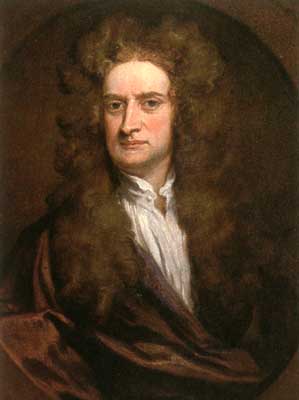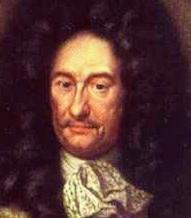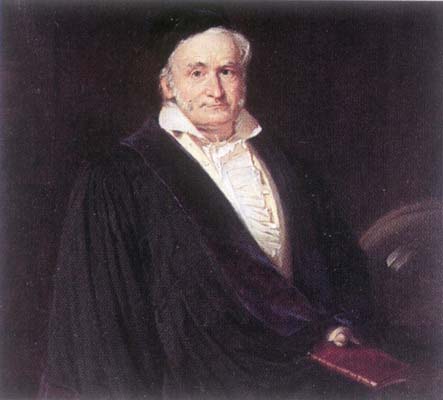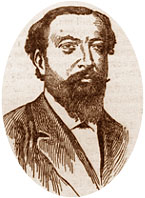 Pythagoras (c. 580 -
500 B.C.)
Pythagoras (c. 580 -
500 B.C.)
 Pythagoras (c. 580 -
500 B.C.)
Pythagoras (c. 580 -
500 B.C.)
Though not much is known of this mysterious man, it is almost
certain that
mathematics began with him. Pythagoras led a half-religious,
half-mathematical group who kept most of their discoveries a secret.
The Pythagoreans credited all their work to their leader and their mottos
became "Everything is number" and "He [Pythagoras] himself has said it".
Pythagoras
came up with the idea of a mathematical proof, as well as his famous
Pythagorean Theorem relating the sides of a right triangle to its
hypotenuse. The Pythagoreans discovered irrational numbers, which to them
was a disaster because the existance of irrational numbers went against
their beliefs. However, this discovery led to opportunities for
mathematicians to come."...three fifths of him genius
and two fifths sheer fudge" - J.R.Lowell
Click
here to learn more about Pythagoras
 Euclid (c. 300 B.C.)
Euclid (c. 300 B.C.)
Few facts have been pieced together about Euclid and in fact
not everyone
is convinced that Euclid was one man. Most people believe that Euclid was the
leader of a group of mathematicians in Egypt who wrote The
Elements, a collection of books on geometry that organized all that
was known on mathematics at his time. Among the topics covered in the 13
books are: plane geometry, number theory, irrationals, and the volume of a
cone. In recent centuries many
of the assumptions made by Euclid have been proven to be false, however it
has been said that the books have had a greater influence on the human
mind
than almost any other work. Euclid was younger than Plato but older than
Archimedes."There is no royal road to
geometry"-Euclid
Click
here to learn more about Euclid
 Archimedes (c.287-212 B.C.)
Archimedes (c.287-212 B.C.)
Archimedes was one of the three greatest mathematicians of
all time.
Though he became famous for many of his inventions, inlcuding the "Screw
of Archimedes" and many war machines he designed for the King of Greece,
his true passion was for pure mathematics. Archimedes found the sum of a
geometric series in such a way as to indicate that he understood the
concept of limits. He also, among other things, calculated pi; used the
sum of infinte
rectangles to find the area under a curve; and found the volume and
surface area of a sphere. Archimedes was killed by a roman soldier when
the soldier walked through a drawing of some circles in the dust and
Archimedes got mad at him. "He was a great civilization
all by himself"- George F. Simmons
Click
here to learn more about Archimedes
 Descartes
Descartes
 Mersenne
Mersenne
 Pierre
Fermat(1601-1665)
Pierre
Fermat(1601-1665)
A lawyer by day and a mathematician by night, Fermat was a
man of obvious genius who never attempted to publish his findings during
the course of his life. Luckily Fermat corresponded with Mersenne and
other mathematicians in Paris and revealed his discoveries. Though Newton
and Leibniz are said to be the inventors of calculus, Fermat certainly had
a hand in it. Fermat found a method of finding maxima and minima which
students today would recognize as setting the derivative equal to zero.
Fermat also invented analytic geometry
and modern number theory. Fermat once left a note in the margin of a book
stating a theorem (Fermat's Last Theorem) but offering no proof, and to
this day no mathematician
has been able to find a proof."And perhaps,
posterity will thank me for having shown it that the ancients
did not know everything."- Pierre Fermat
Click
here to learn more about Fermat
 Pascal
Pascal
 Huygens
Huygens
 Sir Isaac Newton
(1642-1727)
Sir Isaac Newton
(1642-1727)
Newton actually discovered calculus between 1665 and 1667
after his
university closed due to an outbreak of the Plague. Newton
was only 22 at the time, and he preferred not to publish his discoveries.
Meanwhile, in Germany, Leibniz discovered Calculus independently
and he was very open with his findings. This led to a bitter
dispute between the two mathematicians later known as the
"Great Sulk". Today it is well known that both
men discovered calculus independantly of the other, Leibniz about 8 years
after Newton. Newton is best known for his work in physics, and especially his three laws of motion."If I have made any valuable discoveries, it has been
owing more to
patient attention than to any other talents"- Sir Isaac
Newton
Click here to learn more about Newton
 Gottfried Wilhelm
Leibniz (1646-1716)
Gottfried Wilhelm
Leibniz (1646-1716)
Though Leibniz is credited with discovering calculus after
Newton he is
thought to be the true founder of modern European mathematics. Not only
was he a great mathematician, he was also a philosopher, scientist,
logician, diplomat and a lawyer. Leibniz is well known for introducing
notations that are still used in Calculus today, such as 'dy/dx' and the
integral symbol. It is even attributed to him that the '=' symbol is used
throughout the world."It is rare to find learned men who are clean, do not
stink, and have a sense of humour"- the Dutchess of Orleans, on
Leibniz
Click
here to learn more about Leibniz

 The Bernoulli
Brothers
The Bernoulli
Brothers
 Euler(1707-1783)
Euler(1707-1783)
It is hard to believe
that a man with 13 children who went blind for the last 17 years of
his life was able to publish, on average, about 800 pages a year
throughout his life.
Euler contributed to every branch of pure and applied
mathematics and even discovered some new ones. It has been said that any
elementary or advanced calculus text printed after 1748 is basically a
copy or a copy of a copy
of Euler. Thanks to Euler we have symbols for pi and e. He also did
extensive work on infinite series and amazed his teacher, Johann
Bernoulli,
by finding the sum of a particular series. Euler managed, with writers to
help him, to publish even more work after going blind."[Upon losing the use of his right eye] Now I will have less
distraction"-Euler
Click
here to learn more about Euler
 Fourier(1768-1830)
Fourier(1768-1830)
A French mathematician, Fourier was torn between his
father's desire
for him to enter the priesthood and his real interest in mathematics. By
the age of 14 mathematics won out. He became involved in the aftermath of
the French Revolution and even became an acquaintance of Napolean's. At one
point he was imprisoned and destined for the guillotine, but he was
eventually freed instead. Fourier is best known for the series that bears
his name. He also expanded the definition of a function. Riemann used the
Fourier series to define a definite integral, and the series has also
been used for many other applications to physics."Fourier
is a mathematical poem"- Lord Kelvin
Click
here to learn more about Fourier
 Johann Carl
Friedrich Gauss(1777-1885)
Johann Carl
Friedrich Gauss(1777-1885)
Perhaps the greatest mathematician that ever lived, Gauss'
talent was recognized from an early age by his elementary school teachers
in Germany. At the age of 15 Gauss entered Brunswick Collegium Carolinum
and there he independantly discovered many mathematical laws and theorems.
Gauss made contributions to many areas including number theory,
differential equations, conics, and differential geometry. His work never
suffered, despite personal tragedy. Whithin one year his father, wife and
son all passed away. Gauss is said to have discovered non-Euclidean
geometry although he never published anything on the matter because he did
not want to ruin his reputation. "If others would but
reflect on mathematical truths as deeply and continuously as I have, they
would make my discoveries."-Gauss
Click
here to learn more about Gauss
 Augustin Louis Cauchy(1789-1857)
Augustin Louis Cauchy(1789-1857)
For all his genius, Cauchy was strongly disliked by most
of his
contemporaries, and has even been described as a narrow-minded bigot.
However, he did make some great contributions to calculus including the
first proof of the convergence of a Taylor series as well as a rigorous
treatment of limits, derivatives, and integrals. Cauchy came second to
Euler in terms of productivity, filling 27 volumes with his
discoveries."Cauchy is mad and there is nothing that can
be done
about him, although, right now, he is the only one who knows how
mathematics should be done." - Abel
Click here to learn more about Cauchy
 Abel
Abel
 Johann Peter
Gustav Lejeune Dirichlet(1805-1859)
Johann Peter
Gustav Lejeune Dirichlet(1805-1859)
Dirichlet's idol was Gauss and supposedly he carried
around Gauss'Disquisitiones arithmeticae wherever he went.
Dirichlet is best known for his work on number theory and analysis. In
1829 he gave a definition of a function that is still used today. He said
that y is a function of x when each value of x in a given interval has a
unique value of y. Later in his life
Dirichlet became a friend of Gauss,
and succeeded him as a professor at the University of
Gottingen.
Click
here to learn more about Dirichlet
 Liouville
Liouville
 Hermite
Hermite
 Lord Kelvin (William
Thomson)(1824-1907)
Lord Kelvin (William
Thomson)(1824-1907)
Lord Kelvin gained fame and fortune when he invented the
mirror
galvanometer, a mechanism that could be used to translate morse code sent
over the Atlantic Ocean. A man by the name of Whitehouse was working on
the same project and in an effort to beat Thomson he secretly started
using the instrument. In the end Thomson gained all the deserving
credit. Thomson's father taught him mathematics and at the age of ten he
entered university though he did not start university level courses until
the age of 14. He applied math to heat flow using Fourier analysis (which
involves trigonometric integrals) and
this eventually led him to his most famous (and lucrative) discovery. Lord
Kelvin also devised the absolute temperature scale that bears his
name."When you are face to face with a difficulty, you
are up against a discovery."- Lord Kelvin
Click
here to learn more about Lord Kelvin
 Bernhard
Riemann(1826-1866)
Bernhard
Riemann(1826-1866)
Riemann showed an interest in mathematics form an early
age but when he
first entered university it was in the faculty of theology, to please his
father. However, soon after, with permission from his father, he switched
to mathematics at the University of Gottingen where Gauss was head of
mathematics. A year later Riemann left and went to school in Berlin, for
Gauss was unapproachable, especially to lowly first year students, and in
Berlin he was accepted with open arms by Dirichlet. A few years later
Riemann returned to Gottingen and impressed Gauss with a very famous
lecture on geometry. He would eventually become a professor at the
university. Riemann's definition of an integral is still used in virtually
all text books today. Riemann died at the young age of 39 from
tuberculosis and for this reason published a relatively small (yet
important) amount of work. He left mathematicians to follow the
Riemann Hypothesis, which has yet to be solved.
Click
here to learn more about Riemann
"Mathematics is not a careful march down
a well-cleared highway, but a journey into a strange
wilderness, where the explorers often get lost. Rigour should
be a signal to the historian that the maps have been made, and
the real explorers have gone elsewhere." - W.S.Anglin
References: Simmons, G., Calculus with analytical geometry (McGraw-Hill: New
York,
1985)
The Mactutor History of Mathematics archive http://www-gap.dcs.st-and.ac.uk/~history/index.html